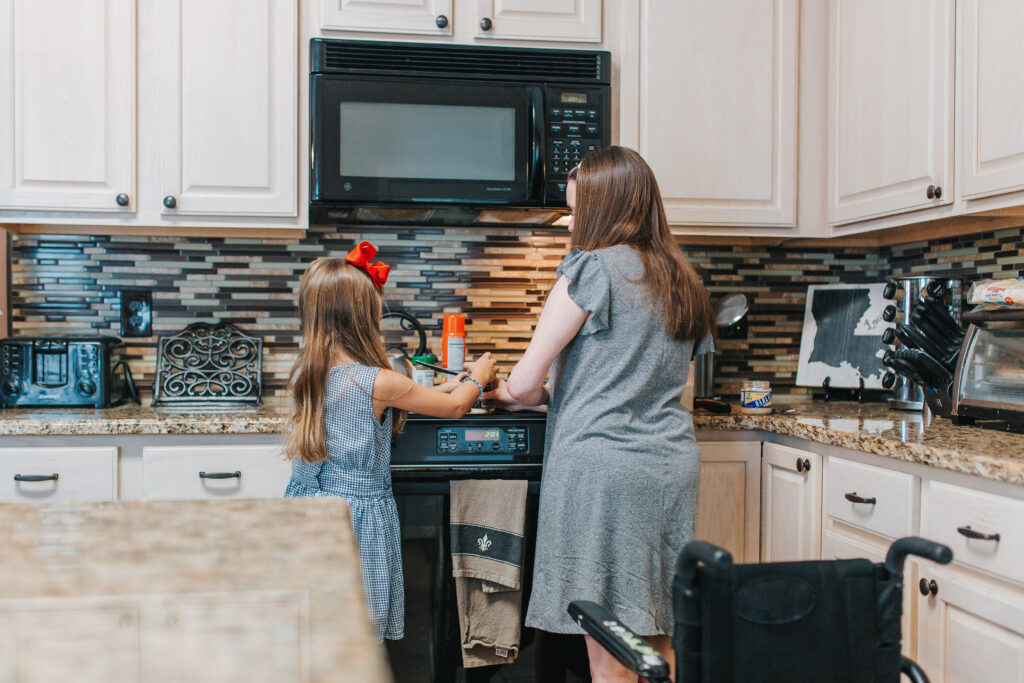This blog was inspired by a conversation with a client who was “frustrated beyond belief” at mealtime.
One year, I decided that one of the “chores” my daughters would be responsible for was helping in the kitchen.
I didn’t enforce this as much as I probably could have/should have at the time. But “Helpers in the Kitchen” came in very handy during the pandemic when everyone was home!
Each daughter was responsible for preparing one full meal (lunch or dinner) each week. I asked that they mix it up = not always make the same meal and not always choose lunch (or dinner).
If you have been in one of my Chores presentations/classes, you know that I consider chores to be life skills. I believe every family member should participate in chores. I have lots of suggestions on how to approach this, how to involve your family, and how to mix things up. All while offering age-appropriate chores for everyone.
Being responsible for preparing a full meal starts with planning what will be served.
It also includes making sure you have all the ingredients. And finally, it involves making, serving, and cleaning up after the meal. In our house, I am often willing to help clean up if someone else makes the meal. 😉

This was a great life lesson and FYI: it required a bit of supervision and guidance in the beginning.
Just asking my family to write things on the grocery list was not super successful. Most kids live “in the moment” and don’t have the ability (or desire) to think ahead to next week.
I had to sit down with everyone individually and talk about what they wanted to serve the next week. I explained that we needed to do this in advance so that I could buy the groceries (when it was convenient for me!).
We also talked about how much time each meal would take. For example, rice cooks fast and doesn’t require a lot of interaction while sauteeing vegetables is a different story.
Over the course of time, it was neat to see how my daughters chose the meals they were going to make. Sometimes it was “I need a fast one next week” (= sandwiches, fruit, and snacks for lunch). Other times it was “I’m going to experiment and make something foreign (or new)!”
Looking back, I remember that not all of our chore-meal prep experiences were flawless (occasionally there was pushback or tears). However, because we set them up for success, most of the meals went well!
Most of the meals went well because they were set up for success.
There was not a lot of pressure (no one opted to prep a meal for a large party/out-of-town guests).
We spent time together as we talked about the meal they would make the next week. We either scheduled time to do this or did it at the dinner table (= captive audience).
After all the planning, we got to spend quality time in the kitchen together with the daughter taking the lead.
And, since everyone was required to make a meal each week, we each knew that we would have a few nights off. I like to think this helped some of us learn to appreciate how much time and effort goes into making meals.
“Helpers in the Kitchen” did not work miracles. No one jumped up to help me most other nights and no one volunteered to continue this throughout the busy school year after the pandemic… but it was fun while it lasted!

Even though I miss them helping out in our kitchen, now that they’re in college, I know that our daughters have several meals they can easily make on their own! They know how to plan, prepare (follow a recipe/create something new), and serve the meals.
I highly recommend giving the chore “Helpers in the Kitchen” a try. Start small with little expectations. The better you communicate what you want the end result to be, the better you are all set up for success.
I’d love to hear how it goes if you try it!
If you haven’t had a chance to read them yet – I have two other blogs you should check out: Dinner Brainstorm List (Part 1) and 20 Freezer Meals In a Weekend (Part 2) and the interesting surprises I found.

Leave a Reply